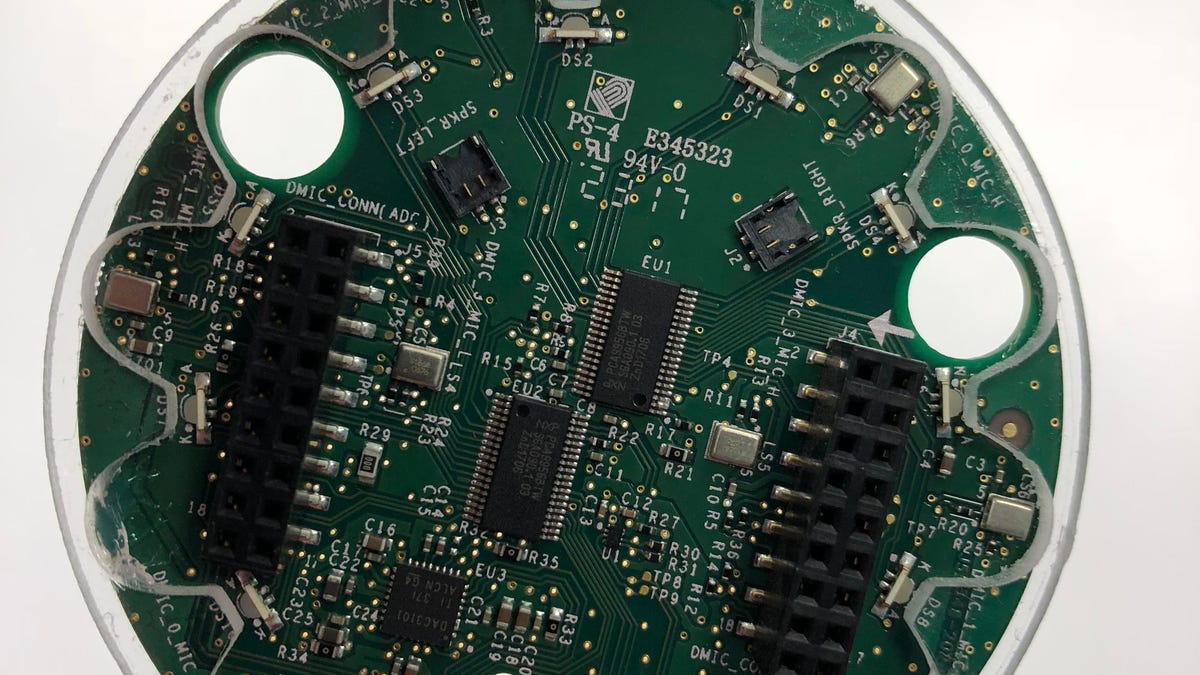 Why You Can Trust CNET
Why You Can Trust CNET Intel wants to be inside your Alexa devices
With a vision for improving the smart home, and a new Alexa developer's kit, Intel has a plan to grow its profile in the smart home.

The 8 microphone array board in Intel's new Alexa developer kit. The tiny silver pieces, six along the edge, two in the middle, are the mics.
As mobile devices have taken over our lives, PC sales, and sales of Intel 's computer chips, have declined. Intel hasn't had a lot of luck transitioning to the mobile chips business, but it doesn't intend to let the same thing happen in the growing smart home market. In a small lab festooned with smart home gadgets in Intel's Santa Clara, California headquarters, Miles Kingston, general manager of Intel's Smart Home Division, mapped out for me how Intel plans to seize this opportunity.
The smart home represents a significant growth opportunity in consumer technology. A study by Zion Market Research projects the value of the smart home market will go from $24.1 billion in 2016 to $53.45 billion by 2022, an increase of more 130-percent. Any company that can capture a significant piece of that market, either through software, hardware, or the delivery of services, stands to benefit.
"We feel that the home is extremely connected, but not really smart yet" says Kingston.
To determine what "really smart means" Intel conducted a study on families in the US, China and Western Europe. Based on that study, Kingston says the company has landed on a set of technology ideas to meet what it predicts consumers will want from a smart home, now and in the future.
Among them, fast connectivity inside and into the home, voice control through the home and microphones and visual sensors that can inform the house about what's going on.
"Imagine devices with microphones that can listen for anomalies -- glass breaking, a baby crying, a dog barking. I don't want to say 'always listening,' because that's concerning, but that it's listening for more than just a wake word [like 'Alexa']."
The last piece is a robust artificial intelligence layer that can interpret all of that data, with the end result making the home, says Kingston, "more perceptive, more responsive and more autonomous."
One immediate piece of that picture Intel is tackling is voice adoption. The company is today releasing the awkwardly named Intel Speech Enabling Development Kit. Essentially, it's a set of Intel engineered circuit boards with audio processing chips and up to eight microphones, an industry high, designed to accelerate the development of products for Amazon's Alexa platform.
Intel hopes to put its new development kit into the hands of third-party device manufacturers to help speed the development of their Alexa compatible products beyond speakers.
To help get word out about its partnership with Amazon, Intel has sent an Airstream trailer barnstorming around 20 US cities this summer.
Eventually, Kingston says, Intel will release more Alexa development kits that add new and different features for smart home device makers. Intel's kits could technically work with voice platforms from other companies like Google, Apple and Samsung, but Kingston wouldn't comment on any future plans to support Amazon's competition. Intel itself will be competing against the other Alexa development kits already out there.
Beyond the development kits, Intel also has its Atom CPU in two of Amazon's Alexa devices, the Echo Show video hub and the Echo Look fashion assistant camera. The Echo Look also contains Intel's RealSense camera technology.
While those count as wins, none of Amazon's most recently announced Echo products contain Intel hardware, including the Echo Spot, essentially a smaller, cuter version of the Show.
"We're going to continue to keep working to get into as many of those products as we can," says Kingston. I joke about one day buying a smart lock with a PC-style Intel Inside sticker slapped on the side of it. He doesn't think that's likely, but he still hopes one day consumers will seek out smart home products specifically because they're made from Intel silicon. "We're somewhat starting from scratch in establishing our value in this space."

